MARIANI’S
May
24, 2009
NEWSLETTER

U.S. Army Ration, World
War II
Remember Memorial Day
~~~~~~~~~~~~~~~~~~~~~~
QUESTIONS? TO REACH JOHN MARIANI WRITE
TO: newsletter@johnmariani.com.
ARCHIVE: Readers may now access
an
Archive of all past newsletters--each annotated--dating back to July,
2003, by simply clicking on www.johnmariani.com/archive
SUBSCRIBE AND
UN-SUBSCRIBE: You may subscribe anyone you wish
to this newsletter--free of charge--by
clicking here.
~~~~~~~~~~
In
This Issue
THE CITY THAT SILVER BUILT—SAN MIGUEL DE ALLENDE by John Mariani
NEW YORK CORNER: Apiary by John MarianiNOTES FROM THE WINE CELLAR: Mohawks and Merlot - Not Your Father’s Wine Expo
by Jacqueline Church
QUICK BYTES
~~~~~~~~~~~~~
THE CITY THAT
SILVER BUILT—SAN MIGUEL DE ALLENDE
by John Mariani
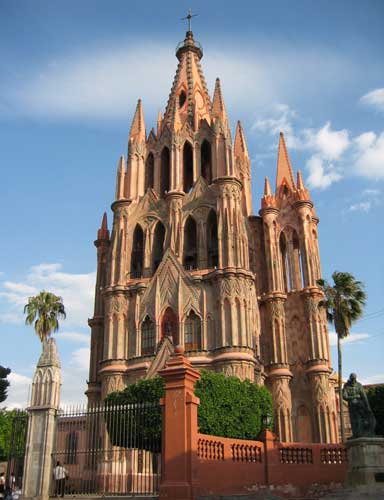 As
much as we’d all like to believe that Mexico is still dotted with
pretty colonial towns in remote areas that have remained relatively
untouched by time, few would fit that description with any degree
of artistic and historic interest. The rare, outstanding example is San
Miguel de Allende, founded by the Spanish in 1542 as an important
stop along the silver route of the Antiguo Camino Real in Guanajuato
province, a good 170 miles from Mexico City. For its wealth from
the silver trade it was once nicknamed San Miguel El Grande.
As
much as we’d all like to believe that Mexico is still dotted with
pretty colonial towns in remote areas that have remained relatively
untouched by time, few would fit that description with any degree
of artistic and historic interest. The rare, outstanding example is San
Miguel de Allende, founded by the Spanish in 1542 as an important
stop along the silver route of the Antiguo Camino Real in Guanajuato
province, a good 170 miles from Mexico City. For its wealth from
the silver trade it was once nicknamed San Miguel El Grande.
Its 6,400-feet altitude keeps it temperate and dry, the heat down in
the sixties, and the scenery of
mountains and flowering deserts have made it a reclusive spot for a
generation of well-heeled Americans who have relocated here or bought
second homes in the area. Many came after World War II, when
G.I.s on education grants came to study art; many stayed on,
renting apartments for ten bucks a month, and the establishment of the
language art school Intituto Allende became an enormous draw for
artists. It took on more
cult-like interest for Americans when Ken Kesey brought his
“Merry
Pranksters” tour here in the 1960s. Allen Ginsburg visited; the beat
writer Neal Cassady died by the side of nearby railroad tracks. Bummer.
The town itself, with about 140,000 inhabitants, swelled with visitors
and second-homers, bustles,  but
without
much motor traffic and with a tranquil quiet that makes walking around
town a joy, visiting the monuments and churches, and the famous fine
arts school here, Escuela Universitaria de Bellas Artes. The city
itself last year was awarded status as a World Heritage Site, a
tremendous achievement based on its maintaining of the old charms and
colonial links to Spain, which has also made it popular as a movie
location.
but
without
much motor traffic and with a tranquil quiet that makes walking around
town a joy, visiting the monuments and churches, and the famous fine
arts school here, Escuela Universitaria de Bellas Artes. The city
itself last year was awarded status as a World Heritage Site, a
tremendous achievement based on its maintaining of the old charms and
colonial links to Spain, which has also made it popular as a movie
location.
The hub of life is the city's
square set with huge Indian laurel trees. Here people come to
stroll, sell their wares and tacos, and at night to listen to the
mariachi bands that come through in their silver-speckled outfits and
huge sombreros, singing the old Mexican romantic songs, from "Cielito
Lindo" to "Vaya con Dios." You can make this park the center from which
you radiate to the rest of the city, which is easily covered in a
couple of hours, up and down cobblestone streets, into the many old
churches, and into the myriad art galleries in gaily painted buildings.
These include craftsmen who make nichos,
made from hole-punched tin, which take on an astounding number of forms
in
sculpture, frames, and geegaws.
The streets have lovely old
names--Piedras Chinas, Calzarda de la Luz, Pila Seca, Hospicio, and
Bajada de Oca. Down one old street is a spot where people still
come to wash their clothes in ancient stone laundry basins/
The
best place in town to stay, with two excellent restaurantes, is Casa de Sierra Nevada, an
Orient-Express property, whose
premises date to the
16th and 18th centuries, now a National Monument, with 32 rooms 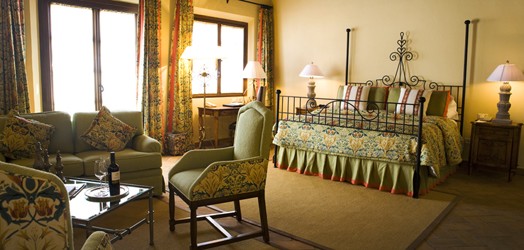 that have on occasion been
occupied by everyone from Sharon Stone and Salma Hayek to Johnny Depp
and Harrison Ford. There is a 60-foot swimming pool, beautiful
library, and a superb array of folkloric art. The
rooms (right) are
exceptional for their size,
stunning antiques, and the peacefulness of the place, when the only
sound you hear from the roof, where the pool is located, will be the
bells tolling from the town churches. You peer out over the city, at
sunrise or twilight, at midday or midnight, and you feel very removed
from the rest of Mexico, even the rest of your world back home, and you
feel at ease.
that have on occasion been
occupied by everyone from Sharon Stone and Salma Hayek to Johnny Depp
and Harrison Ford. There is a 60-foot swimming pool, beautiful
library, and a superb array of folkloric art. The
rooms (right) are
exceptional for their size,
stunning antiques, and the peacefulness of the place, when the only
sound you hear from the roof, where the pool is located, will be the
bells tolling from the town churches. You peer out over the city, at
sunrise or twilight, at midday or midnight, and you feel very removed
from the rest of Mexico, even the rest of your world back home, and you
feel at ease.
The more casual restaurant at the Casa is Parque (below), set down a cobbled
street within a colonnaded patio. Here you may begin savor three
moles—black, green, and
red—over pan-seared chicken with rice and
refried beans, and the traditional molcajete
arriero—a marinated flank
steak with pan-seared cheese, nopales
cactus,
the spicy chorizo sausage, and a
green salsa. It is a beautiful, quiet place to have breakfast in the
cool
mornings here. You may also dine outdoors or in the private Salon del
Obispo with friends.
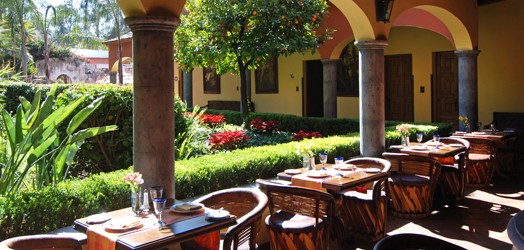 The slightly less casual but far more inventive
restaurant, across the street from the Casa, is Andanza (below), a
shadowy, candlelit room in an open courtyard with a babbling water
fountain and orange trees that perfume the air. You may eat in the
courtyard or at one of six different indoor
rooms, all sumptuously set with period furniture, fine leather chairs,
and there is a charming wine room worth taking a peek at. Start off
here with a well-made
margarita or sangrita at the convivial Blue Bar, then sit down to chef
Gonzalo Martinez’s
stylish and very colorful cuisine—perhaps a starter of ceviches with a
truffle-parmesan foam. Or tuna marinated in achiote with a classic
potato fondant, fennel, chorizo and caramelized onions.
The slightly less casual but far more inventive
restaurant, across the street from the Casa, is Andanza (below), a
shadowy, candlelit room in an open courtyard with a babbling water
fountain and orange trees that perfume the air. You may eat in the
courtyard or at one of six different indoor
rooms, all sumptuously set with period furniture, fine leather chairs,
and there is a charming wine room worth taking a peek at. Start off
here with a well-made
margarita or sangrita at the convivial Blue Bar, then sit down to chef
Gonzalo Martinez’s
stylish and very colorful cuisine—perhaps a starter of ceviches with a
truffle-parmesan foam. Or tuna marinated in achiote with a classic
potato fondant, fennel, chorizo and caramelized onions. 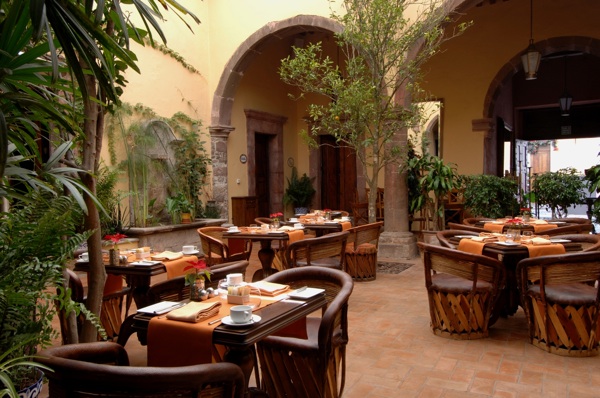 His lamb
chop with barbecue ravioli in a flavorful consommé with grilled
onions and oven-dried tomatoes is a triumph of intertwined flavors and
textures. The orange leaf-marinated duck breast with a duck tamale,
guajillo and queso blanco shows how the
traditional may be combined
with modern ideas that are starting to stir in Mexico. All of
these dishes may be accompanied by Mexican wines that show enormous
promise. (Both Parque and Andanza are open for breakfast, lunch,
and dinner.)
His lamb
chop with barbecue ravioli in a flavorful consommé with grilled
onions and oven-dried tomatoes is a triumph of intertwined flavors and
textures. The orange leaf-marinated duck breast with a duck tamale,
guajillo and queso blanco shows how the
traditional may be combined
with modern ideas that are starting to stir in Mexico. All of
these dishes may be accompanied by Mexican wines that show enormous
promise. (Both Parque and Andanza are open for breakfast, lunch,
and dinner.)
The town is of course dotted with
restaurantes and
eateries, including an odd lot of Italian, Chinese, and
fusion places, believe it or not. For very cheap but good eats, try Cha
Cha Cha (Calle 28 de Abril #37),
where main courses go for about five
bucks. Planta Baja (Canal 28)
is more global, though Mexican in
spirit, and it's known for its style and--for San Miguel--higher
prices, which for Yanquis works out to about $15 a main course.
There is also a well-known Sazon
Cooking School, whose recipes have been featured in Gourmet
Magazine, and where Chef Paco Cardenas demonstrates the
long traditions of Mexican cuisine.
After a margarita or two or some shots of sangrita or a flight of
añejo tequilas, you may follow your
own hired mariachi band to play and sing and dance down the darkened
streets of the old town. If you plan carefully, you should go to do so
at full moon, when
the town is brightened by a silvery light and long, romantic shadows
lounge among the colonnades.
~~~~~~~~~~~~~~~~~~~~~~~~~~~
NEW YORK CORNER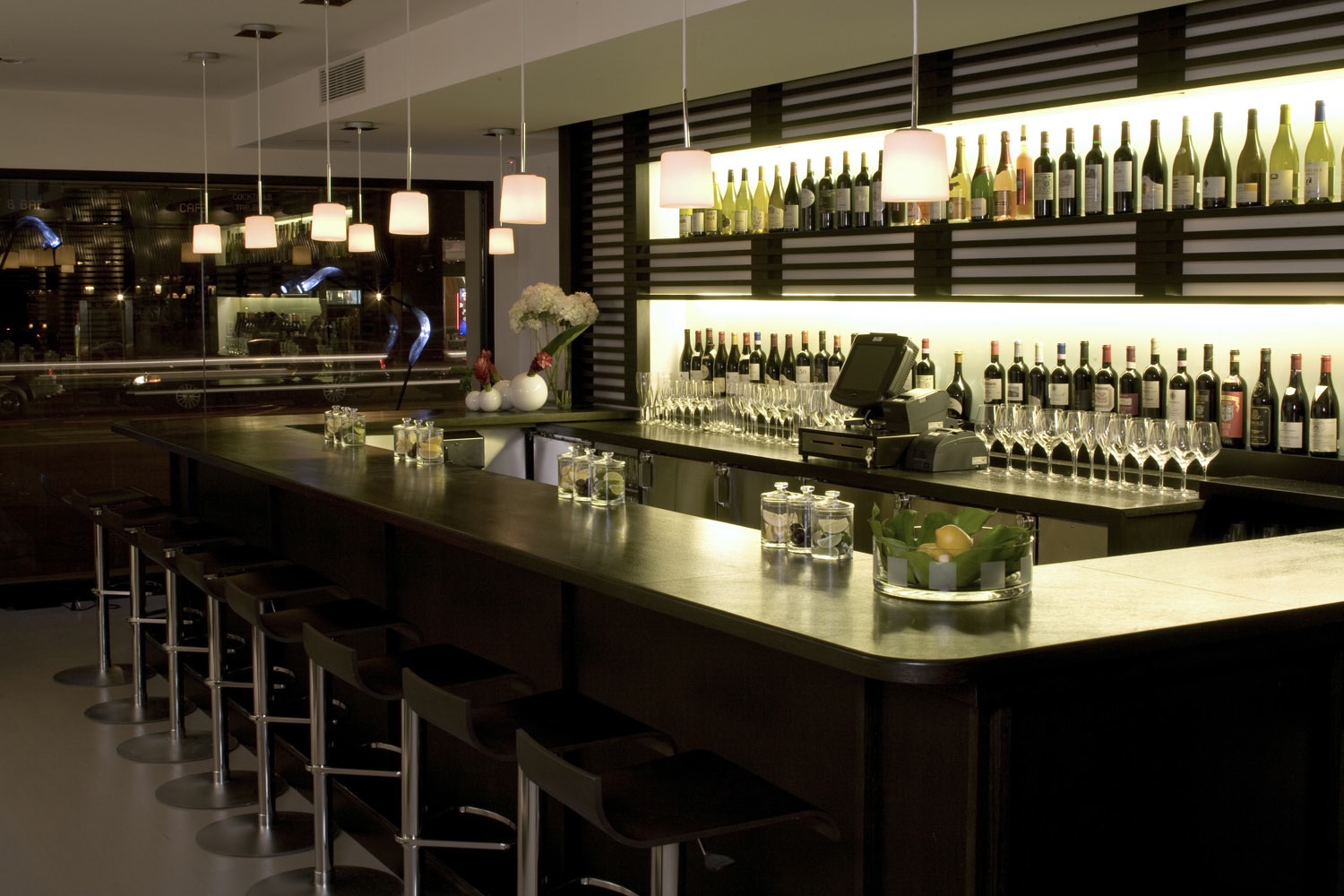
apiary
60 3rd Avenue (near
11th Street)
212-254-0888
www.apiarynyc.com
the
breadth and depth of culinary talent in NYC is nothing short of
extraordinary, even in times that try chefs' souls. Recession,
re-schmession, NYC always
costs more for everything, restaurant rents
are outrageous, sanitation (lovingly referred to as "carting"), high
taxes, sometimes demanding unions--all make it very
tough to do business even in boom times. Yet the best chefs all want
to come to NYC, apprentice here, learn here, and, very often, stay
right here, even if they've come from all over the country or the
world. They don't call it the Big Apple for nothing, and chefs
like Scott Bryan of Apiary stand out among peers.
Back in 1996 Food
& Wine awarded him Best New Chef honors and the NY Times three stars when he was
at Veritas. Prior to that he'd
worked at top kitchens
like Gotham Bar & Grill, Bouley,
Le Bernardin, and
Lespinasse--going through
such illustrious swinging doors makes you
ready for
anything. As a veteran of 25 years in
the business he is at Apiary, a darling, small restaurant
in a
neighborhood bereft of good ones. It's smart, sleek but
un-trendy, with superb and flattering lighting, buffed ebony wood,
burgundy
upholstery on geometric Luca chairs, and a magical laser-cut silhouette
of an
ancestral chandelier. The place has been carefully designed
without looking overly so, so its casual ambiance is buoyed by some of
the nicest staff members you'll meet in NYC--not the Lower East Side
types who dress like homeless men and tell you "everything on the menu
is awesome."
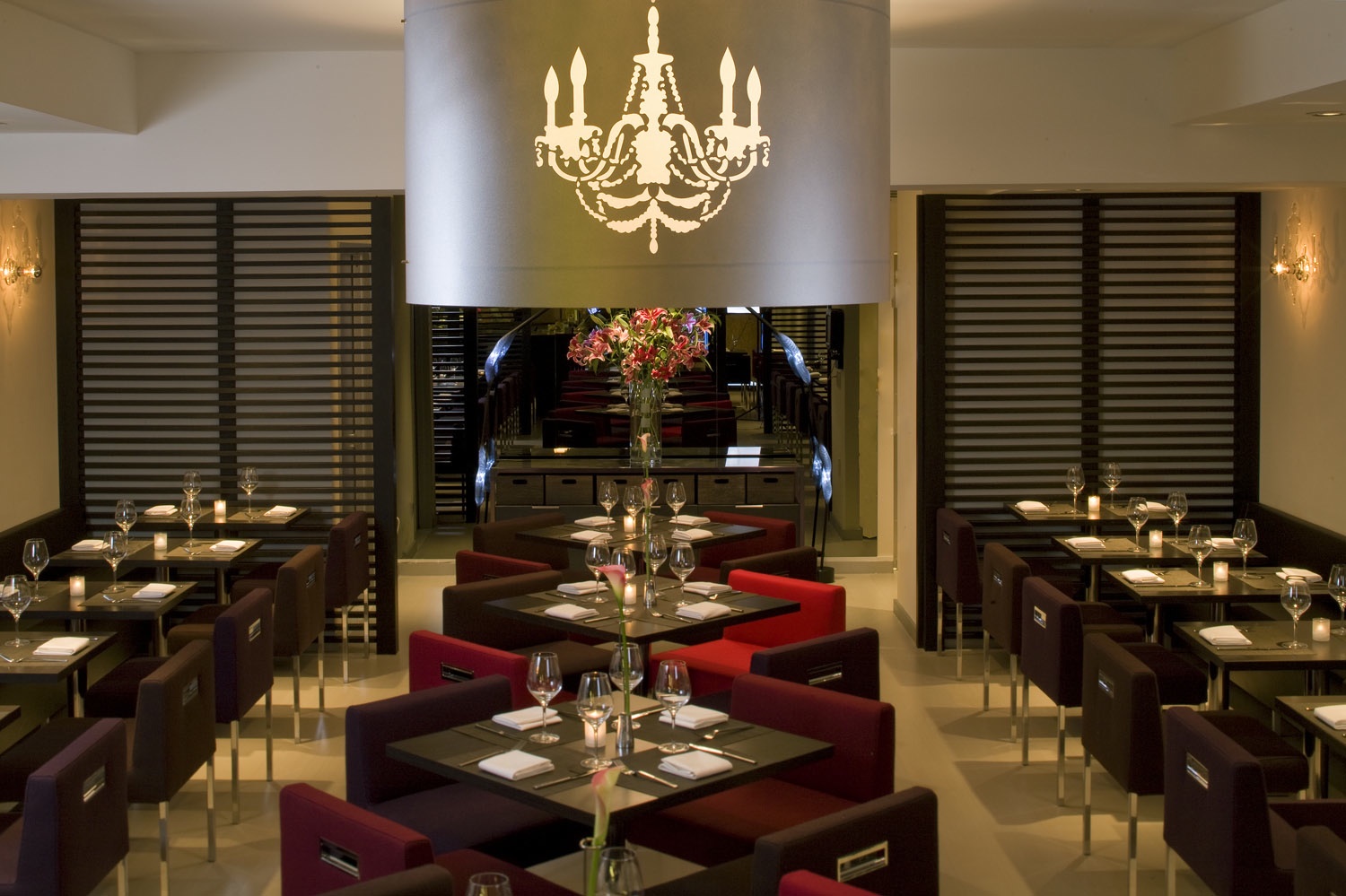 Apiary
has a menu wholly fitted to the times, with prices to boot, with no
main courses over $28 and a three-course dinner at $35. Monday
is Apiary’s “No Corkage” Night. There's a fine selection of decently
priced wines, an array of teas, and artisanal honeys. The cheese
selection is only $13. No wonder the place was packed the weekday night
I dined
there; yet the noise level was surprisingly good,
despite bare tabletops.
Apiary
has a menu wholly fitted to the times, with prices to boot, with no
main courses over $28 and a three-course dinner at $35. Monday
is Apiary’s “No Corkage” Night. There's a fine selection of decently
priced wines, an array of teas, and artisanal honeys. The cheese
selection is only $13. No wonder the place was packed the weekday night
I dined
there; yet the noise level was surprisingly good,
despite bare tabletops.
Bryan (below)
has a knack for making comfort foods sumptuous. Thus, a Tuscan bean
soup with black kale and parmesan is ideal for a spring evening
starter, light, the beans absorbing simple flavors and seasonings.
Crispy sweetbreads came with a tangy romesco sauce, and a Thai-inspired
squid salad was perky with lemongrass, ginger, and mint and crunchy
with peanuts. Everyone's doing hamachi
crudo these days (crudo is
the new word for sashimi), but Bryan's gains from the soft texture of
avocado with the delicate toothiness of shaved fennel, and a subtle
shot of jalapeño pepper.
you'll
also find a lot of duck confit
around town, and Bryan's is as good as any, cuddled in a celeriac puree
with French green lentils--classic and very good. As was Atlantic
skate--a species not seen nearly enough but gaining stature because it
is not expensive--with a light chowder suffused with smoked bacon,
razor
clam, and a touch of tarragon. 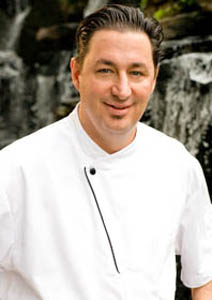 The
grilled Berkshire pork loin comes with Brussels sprouts (for once not
overcooked), glazed Tokyo turnips (whatever they are), and a dousing of
Calvados apple brandy. I often judge a cook by his way with roast
chicken, and Bryan's is an organic bird, with the very crispiest of
skin (I suspect he gives it a flash frying at the end), rich mascarpone
polenta, wild mushrooms, and a Madeira jus. Don't miss the orzo "mac &
cheese," which sublimates that homey dish to a heavenly richness.
The
grilled Berkshire pork loin comes with Brussels sprouts (for once not
overcooked), glazed Tokyo turnips (whatever they are), and a dousing of
Calvados apple brandy. I often judge a cook by his way with roast
chicken, and Bryan's is an organic bird, with the very crispiest of
skin (I suspect he gives it a flash frying at the end), rich mascarpone
polenta, wild mushrooms, and a Madeira jus. Don't miss the orzo "mac &
cheese," which sublimates that homey dish to a heavenly richness.
This is food full of marvelous flavors,
and it carries through in the excellent desserts, from a blackberry
financier cake to a
apple tarte Tatin
and a vanilla panna cotta
with
raspberry coulis--each with a
suggested glass of dessert wine.
Apiary's only problem is that it
has so much competition in NYC these days at this high level of
cooking. The added bonus here, however, is the hospitality, the
lovely setting, and prices that would have been generous five years
ago. And you don't have to taxi down to some funky, cramped,
noisy storefront or pay $25 for a plate of pasta here. Apiary
buzzes with good vibes and delicious food. My congratulations to Scott
and his crew for bringing it all off with such finesse.
Apiary is now open for
Brunch every Saturday & Sunday and dinner nightly.
~~~~~~~~~~~~~~~~~~~~~~~~~~~~~~~~~~~~~~~~
NOTES FROM THE WINE CELLAR
Mohawks
and Merlot - Not Your Father’s Wine Expo
By Jacqueline Church
The
morning after the Boston Wine Riot, I prepared for my
shower.
Having begun
the previous evening during the afternoon Trade session, I was perhaps
moving a bit slowly dans ma salle de
bains.
Then it happened. I caught my image in the bathroom
mirror.
A Tattoo?! Talk about a fog-cutter! Yes, indeed, it
was quite a party. But what sort of Wine Expo is this, really?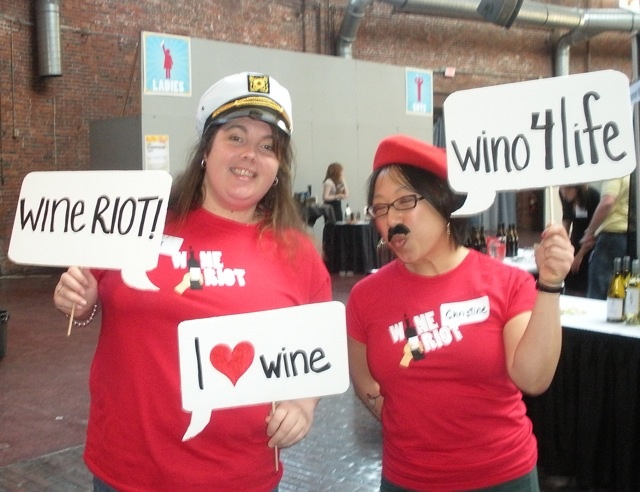
Believing the wine industry “has become overly
complicated and very
pretentious,” Tyler Balliet, editor of The Second Glass, hatched the
idea of the Wine Riot. Balliet seeks to empower new, young oenophiles,
explaining the world of wine “in a down-to-earth and humorous tone.”
Mohawks, boas, fake mustaches and (temporary) tattoos make for an
irreverent and fun event.
While the founders of Wine Riot aim to make
the nouveau expo fun, they
also aim to educate. Some of the antics were a little over the top,
maybe. But loosening up the crowd is clearly part of the educational
plan here. Kirsten Amann, back from a European vacation less than 24
hours, said, “I've never been to a wine tasting that had a funky photo
booth. Or a DJ. And before today, I'd never worn a fake mustache (for a
photo op in said booth.) The atmosphere was decidedly irreverent--and
fun!”
Good wine, like good food, should be accessible to
all. This is one of
the core beliefs of the Second
Glass, which aims to educate new
consumers to the the joys of wine. "We wanted to create an event
where people could learn about wine in fun and social environment,"
states Balliet. "We needed to think outside the box and truly do
something unique and different. It's one thing to say your event is
'snob free' but it's another thing to actually do it." Dale
Cruse, author of Drinks are on Me!
wine blog said “Wine is the
coolest thing to study! The homework is you have to drink it!"
The
Sessions
What
might we actually learn at a crazy
wine expo where boas abound and
Chuck Taylors are chockablock? Having talked to many importers and
vendors at the Trade session, I can
attest to a very low-key approach. Had I wanted to learn more, not just
drink more, the ability to do so was mixed at the tables. Some were
staffed by booth babes, others had the growers and vintners in
attendance. It’s fantastic when you can meet the actual wine makers or
representatives at an uncrowded, relaxed event where they have time to
actually talk to you. For example, I had the opportunity to test my
theory about biodynamic wines with Guillaume Suss of Maison Albert
Bichot before I knew he was a panelist in a later session on the topic.
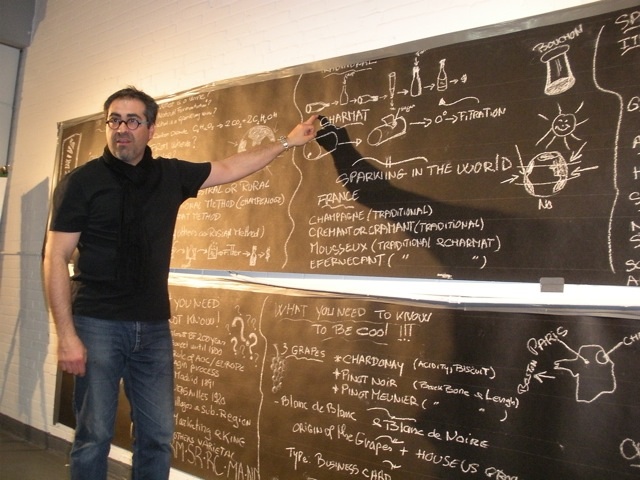 While the Trade tastings could be
of mixed value,
the sessions and
classes were a different story. There, experts were on hand to give the
basics of say, champagne appreciation. This session was delivered
irreverently but accurately by the très
charmant and entertaining
Bertil Jean-Chronberg, general manager and wine director at the Beehive (541 Tremont St., 617-423-0069).
The Champagne session by Jean-Chronberg (left) was intentionally
irreverent but no less educational. Had he taught my 8th grade algebra
class I would actually be able to do math today. I’m certain of it, and
that is really saying something.
While the Trade tastings could be
of mixed value,
the sessions and
classes were a different story. There, experts were on hand to give the
basics of say, champagne appreciation. This session was delivered
irreverently but accurately by the très
charmant and entertaining
Bertil Jean-Chronberg, general manager and wine director at the Beehive (541 Tremont St., 617-423-0069).
The Champagne session by Jean-Chronberg (left) was intentionally
irreverent but no less educational. Had he taught my 8th grade algebra
class I would actually be able to do math today. I’m certain of it, and
that is really saying something.
I also attended a session moderated by
Jonathon Alsop, Director of The
Boston Wine School, on Biodynamic Wines. He had a pretty good
representative panel and fielded questions about biodynamic wines and
the state of the art in organic winemaking. Alsop even had a horn for
show and tell. Bonus points if you know the connection. (In
biodynamic farming, cow horns are used to plant and develop
organic materials for future use treating the soil with the mature
contents; generally in accordance with the lunar calendar.)
Albert
Winestein wine shop owner
Sean Martin
(check the great
soundtrack on their site) had some great wines and an interesting story
to tell, too. Many of the companies there had a decidedly hip or
upstart bent to them. Even those like Bichot, which are hardly
newcomers, exhibited a savvy connection to this new generation of
customers. There was even an app for the iPhone (Drync) as one
might expect.
Christine Liu, editor at City Search and head honcho at 3
Buck Bites
had this to say: “Wine Riot is like a hipster Boston dance night
meets super-friendly and accessible winemakers, with a dose of French
irreverence (in the case of the Beehive's Bertil) and lots of young
and curious drinkers. In short: one tier shy of a beautiful, liberal
grape stomp.”
In sum, it was a very successful inaugural outing
which didn’t cost an
arm and a leg to attend. It didn’t require “gala” attire, and really it
was about the wine. I’d say these kids are alright; of course most
everyone there was too young to get the reference but that’s okay. I’ll
drink to that, (temporary) tattoo and all!
Jacqueline
Church is a Boston-based food, wine &
spirits
writer who has been around since Mohawks were first popular (the
hairdo, not the tribe). She
can be contacted at ldgourmet@gmail.com
~~~~~~~~~~~~~~~~~~~~~~~~~~~~~~~~~~~~~~~~~~~~~~~~~~
WHICH
ALSO EXPLAINED THE COPIES OF HUSTLER
AND PENTHOUSE HE HAD DOWN HIS
PANTS
In Ft. Pierce, Florida, police arrested a
man at a truck stop after finding several packages of candy
and nuts, two black T-shirts and a 20 oz. bottle of beer in the pockets
of a man, who claimed he was justified in stealing candy because
he had served in the military in Iraq and "could steal all the
M&M's he wanted." The man was charged with retail theft and was
being held on $5,000 bail.
 AND
MACAROONS ARE ITALIAN BOILED NOODLES
AND
MACAROONS ARE ITALIAN BOILED NOODLES
In an article about the French food critic François Simon, a New York Times writer misinterpreted the French idiom “un étouffe-chrétien,” a diner’s criticism of macaroons that Simon prepared at a Paris restaurant. The diner was actually saying that the macaroons “could choke a Christian,” meaning they were hard to swallow, not, as the Times writer wrote, “stuffed Christians.”
~~~~~~~~~~~~~~~~~~~~~~~
QUICK
BYTES
* In Chicago, with
the opening of the Art Institute of Chicago’s new Modern Wing, Lockwood restaurant at the Palmer
House Hilton will
be toasting the museum by offering guests a 20% discount off their
lunch or dinner bill with proof of a ticket to the new wing.
Call 312- 917-3404 or visit www.lockwoodrestaurant.com.
*
In Santa Monica, CA, Wilshire Restaurant's Chef Andrew
Kirschner Presents New Bar Menu and "½ Price Wine Monday: for
every bottle on their exceptional wine list. Also, the weekday
Happy Hour is now extended through the weekend. Call 310-586-1707.
* On May 28 in Greenwich,
CT, the Greenwich
Chamber of Commerce Business & Culinary Showcase at the
Hyatt Regency-Greenwich will feature a fashion show of summer apparel
and a “Throwdown Chowder Challenge” by local members and officials,
with
Chef Jean-Louis Gerin of Restaurant Jean-Louis, Bill Rosen, Executive
Chef at F.I.S.H., and Chef Rafael Palomino of Greenwich Tavern,
will choosing the winning chowder. Restaurants and caterers incl.
Avenida Restaurant, Bambou Asian Tapas and Bar, F.I.S.H., the Ginger
Man Restaurant, Le Gourmet Store/Restaurant Jean-Louis, Pomodoro
Pizzeria & Trattoria, et. al.
$15 for members
and $25 for non-members before May 14. Call 203-869-3500.
* The NYC Laboratory School for Collaborative Studies
is hosting TASTES from the Meatpacking District through Chelsea, to
raise funds for the school. Dozens of the city’s best chefs
will cook on the cobble stone pathways of Gansevoort Street and its new
Plaza, incl. 5 Ninth, Amy's Bread, Barocco Café, Billy's Bakery,
Bombay
Talkie, Buddakan, Cookshop, The Green Table, Il Bordello, Klee
Brasserie, Knickerbocker Bar & Grill, La Bottega, Le Gamin Mobi,
Macelleria, Matsuri, Ono in Hotel Gansevoort, Pastis, The Red Cat,
Rocking Horse Cafe, Smorgas Chef, Son Cubano, Spice Market, Tia Pol,
Trestle on Tenth and Zampa, et al.
$35. pp. Visit www.tastesnyc.org/buy_tickets.html.
* Heathman Restaurant
and Bar kicks off its 2009 Dueling Sommelier Dinner Series
where diners determine who is the top sommelier this season. Jeff Groh,
creator of the series and sommelier at the Heathman, welcomes
colleagues Jack Hott from Castagna, Jeff Moore from Wildwood and
Andy Zalman from Higgins, with a 4- course menu by the
Heathman’s Philippe Boulot and continues on June 20th with
guest chef Dustin Clark from Wildwood. Additional dinners featuring
menus from Higgins and Castagna are scheduled for July and Aug.,
culminating with the Grand Finale dinner in Sept. $110 pp.
Call 503-790-7752; visit www.heathmanrestaurantandbar.com.
* On June 2 in Washington, D.C., Chef Robert Wiedmaier’s Brasserie Beck announces a 4-course dinner that marries Belgian beer, Chef de Cuisine David Ashwell’s Belgian fare with selections from Divine Chocolate. Beer Specialist/Thor Cheston will lead the evening along with Erin Gorman of Divine Chocolate. Tix $85 pp. Call 202-408-1717. Visit www.beckdc.com.
* On June 2 in Bellevue,
WA, Chef/Owner John Howie and Sommelier Erik Liedholm continue Seastar Restaurant & Raw Bar’s
wine maker dinner series with a celebration of spring featuring a
4-course menu and the wines of Napa Valley’s Chappellet Winery, joined
by Steve Tamburelli. Call 425-456-1892.
*
On June 6 in Westport, MA,
Westport Rivers Vineyard &
Winery wll hold the Local Wine & Cheesemakers Dinner, with 4
courses featuring a local cheese and wine to match. The evening begins
with an interactive vineyard tour with co-owner and winemaker Bill
Russell. Also on hand, Barbara Hanley of Shy Brothers Farm; Fiore di
Nonno (Somerville, MA) owner/ cheesemaker Lourdes Smith. $75 pp. Visit
www.westportrivers.com; call 508-636-3423.
Everett Potter's Travel Report:

~~~~~~~~~~~~~~~~~~~~~~~~~~~~~~~~~~~~~~~~~~~~~~~~~~~~~~~~~~~~~~~~~~~~~~~~~~
Eating Las Vegas is the new on-line site for Virtual Gourmet contributor John A. Curtas., who since 1995 has been commenting on the Las Vegas food scene and reviewing restaurants for Nevada Public Radio. He is also the restaurant critic for KLAS TV, Channel 8 in Las Vegas, and his past reviews can be accessed at KNPR.org. Click on the logo below to go directly to his site.
~~~~~~~~~~~~~~~~~~~~~~~~~~~~~~~~~~~~~~~~~~~~~~~~~~~~~~~~~~~~~~~~~~~~~~~~~~~
Tennis Resorts Online: A Critical Guide to the World's Best Tennis Resorts and Tennis Camps, published by ROGER COX, who has spent more than two decades writing about tennis travel, including a 17-year stretch for Tennis magazine. He has also written for Arthur Frommer's Budget Travel, New York Magazine, Travel & Leisure, Esquire, Money, USTA Magazine, Men's Journal, and The Robb Report. He has authored two books-The World's Best Tennis Vacations (Stephen Greene Press/Viking Penguin, 1990) and The Best Places to Stay in the Rockies (Houghton Mifflin, 1992 & 1994), and the Melbourne (Australia) chapter to the Wall Street Journal Business Guide to Cities of the Pacific Rim (Fodor's Travel Guides, 1991).

Family Travel
Forum: The
Family Travel Forum (FTF), whose motto is "Have Kids, Still Travel!",
is dedicated to the ideals, promotion and support of travel with
children. Founded by business professionals John Manton and Kyle
McCarthy with first class travel industry credentials and global family
travel experience, the independent, family-supported FTF will provide
its members with honest, unbiased information, informed advice and
practical tips; all designed to make traveling a rewarding, healthy,
safe, better value and hassle-free experience for adults and children
who journey together. Membership in FTF will lead you to new worlds of
adventure, fun and learning. Join the movement.
All You Need to Know Before You Go
~~~~~~~~~~~~~~~~~~~~~~~~~~~~~~~~~~~~~~~~~~~~~~~~~~~~~~~~~~~~~~~~~~~~~~~~~
MARIANI'S VIRTUAL GOURMET NEWSLETTER is published weekly. Editor/Publisher: John Mariani.
Contributing Writers: Robert Mariani,
John A. Curtas, Edward Brivio, Mort
Hochstein, Suzanne Wright, and Brian Freedman. Contributing
Photographers: Galina Stepanoff-Dargery, Bobby Pirillo. Technical
Advisor: Gerry McLoughlin.
Any of John Mariani's books below
may be ordered from amazon.com by clicking on the cover image.
 My
newest book, written with my brother Robert Mariani, is a memoir of our
years growing up in the My
newest book, written with my brother Robert Mariani, is a memoir of our
years growing up in the For those of you who don't think of the Robert and I think you'll enjoy this very personal look at our --John Mariani |
 |
 |
 |
 |
 |
 |
© copyright John Mariani 2009
